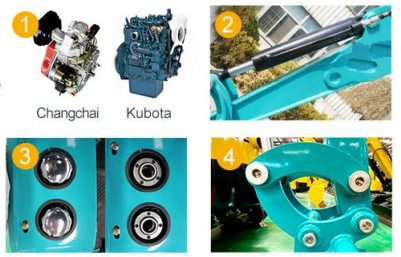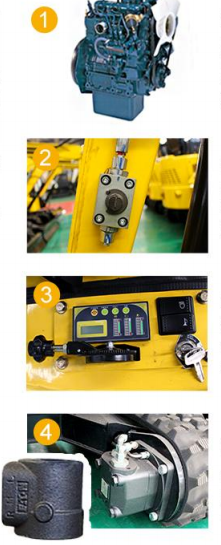Excavator Accessories and Parts
The anatomy of excavators all follow the same general structure, but different types of excavators will have different specifications.
Parts
Crawler Tracks - Usually made of reinforced rubberized steel, these tracks allow the excavator to move over the terrain.
Track Frame - Includes most of the chassis of the machine. This is where the mechanisms that move and rotate the track are located, and where the chassis connects to the rest of the excavator.
Cab - where the operator sits. It contains all the controls for using the excavator and protects the operator from external hazards.
Counterweight - Prevents the excavator from tipping over by balancing the weight of the arm. Their size depends on the weight of the arm and the overall size of the machine.
Engine - The power source of the excavator. Almost all excavators run on diesel fuel. The engine not only allows the machine to drive, but also powers the hydraulics that move the arm.
Boom - The upper part of the excavator's boom. It is attached to the nacelle and usually only moves vertically. Knuckle arms, although less common, have a degree of side-to-side swing.
Stick - The lower part of the excavator arm. Hydraulic cylinders operate the stick, pulling the stick toward the boom to create a digging motion.
Bucket - Attached to the stick, the bucket is attached to a scoopable joint. Barrels are standard, of course, but they're not the only things you can attach to the end of a stick.
Appendix
Bucket - the most common attachment on excavators. All buckets have serrated edges to aid in lifting and digging. Even buckets come in a variety of sizes to suit different needs.
Clips - Some materials may be too large to move safely with just one bucket. The gripper allows the excavator to grab larger objects such as boulders or tree stumps.
Auger - Primarily used for drilling into terrain, these attachments consist of helical blades and hydraulic circuits. Similar to buckets, they come in a variety of sizes, depending on the size of the hole and the material that needs to be drilled.
Crusher - A larger version of the jackhammer mounted on an excavator. They are mainly used to break down strong materials such as stone and concrete. Some crushers can deliver up to 1000 pounds of impact energy.
Couplers - As the name suggests, they are attachments that allow the operator to quickly connect (and disconnect) tools and accessories. Couplers limit how much you can modify the excavator, but they can switch attachments without an entire crew.
Accessories are important parts of the machine. If you want to track everything in your fleet and maximize efficiency, check out our tracking hardware for all your equipment and tools.





